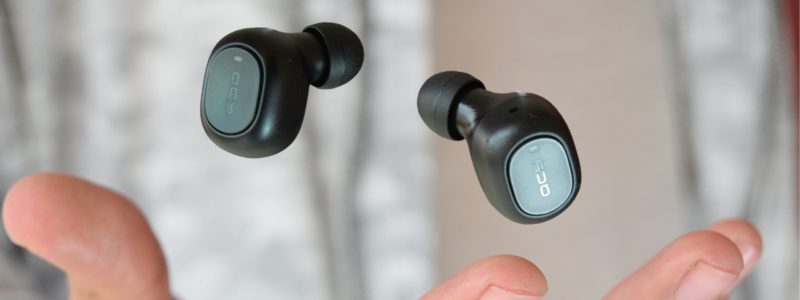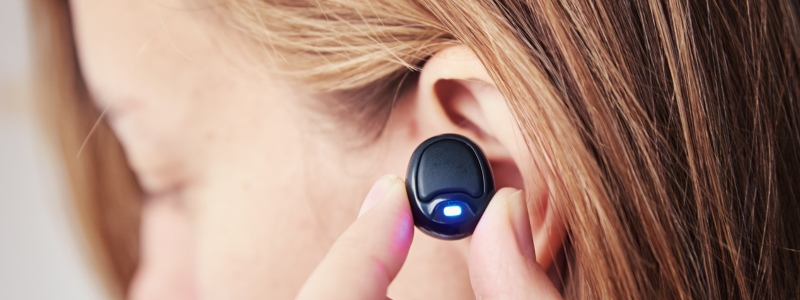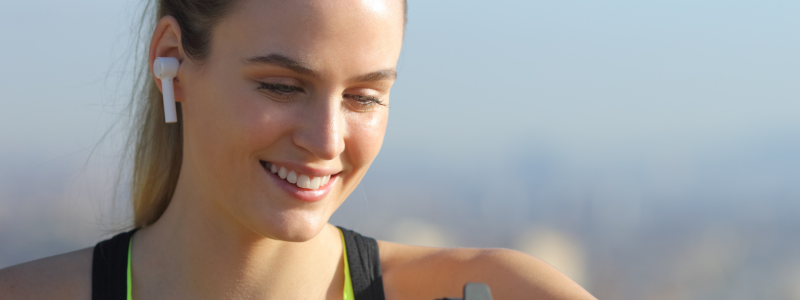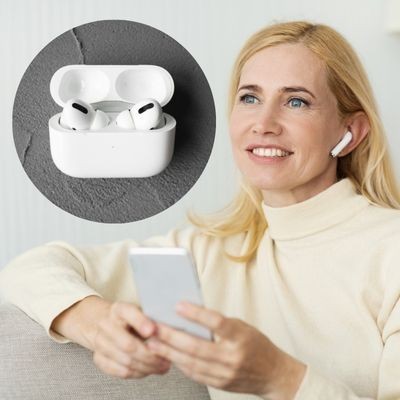
Head of Online Medical Content

Audiology Expert at Hearing Aid UK

Hearing Aids vs Earbuds
What's the difference between the two?
Hearing aids versus earbuds | Benefits of hearing aids | Disadvantages of hearing aids | Benefits of earbuds | Disadvantages of earbuds? | Knowing the difference between the two | Conclusion
Hearing aids versus earbuds
Are earbuds as good as hearing aids? In short, no, and here's why...Hearing aids and earbuds are two very different devices that are designed to serve very different purposes.
While hearing aids successfully support those with hearing loss in amplifying sounds and improving their ability to hear, earbuds are designed to be used for listening to music or other audio content, such as podcasts.
Earbuds cost less but don't support your hearing. Hearing aids do a great job of helping you hear more clearly and easily. In this article, we will explore the differences between hearing aids and earbuds, discuss the benefits the drawbacks of each, and why we should never mistake one for the other.
What are hearing aids?
In short, the hearing aids of today are designed to support those with hearing loss to simply hear better using advanced technology, features, and apps for better personalisation. They are available in a wide range of styles, sizes, and colours, and they can be customised to meet the specific needs of the user and hearing loss level.
But first, what are hearing aids and what are the benefits of hearing aids?
One of the main benefits of hearing aids is that they specifically address and tackle the everyday challenges of hearing loss successfully. They do this by amplifying certain frequencies to help you hear speech, sound, and music clearly.
Hearing aids include advanced feature sets such as noise reduction and directional microphones. These combined features further improve your ability to hear in challenging listening environments. They are also available in a range of price points, from budget-friendly options to premium-level models with advanced features.
Modern hearing aids are more discreet than ever, including Behind Ear styles. Some are even practically invisible! Gone are the days of the bulky brown banana, which tended to make wearers feel self-conscious about wearing them.
What are the disadvantages of hearing aids?
However, while there are not many, there are still some drawbacks to hearing aids. For example, they require regular maintenance and cleaning. This might be considered to be time-consuming and inconvenient for some hearing aid users.
Hearing aids might also not be suitable for individuals with profound hearing loss, as they may not provide enough amplification to be successful. In cases such as these, cochlear implants might be the right treatment.

Hearing Aids Versus Earbuds
Looking at the differences between earbuds and hearing aids and how they compare
What are earbuds? Are earbuds a good alternative to hearing aids?
Earbuds are also known as over-the-counter (OTC) earbuds and non-prescription earbuds. They are primarily designed for listening to audio content such as music, podcasts, or audiobooks. Earbuds are small, user-friendly, and portable, making them a popular choice for people who are on the go.
Earbuds are also available in a range of styles and sizes. Such as wired earbuds and wireless models with advanced features such as noise cancellation and touch controls. However, as OTC hearables and wearables become more popular, it’s even more important not to mix up audiology treatments, such as hearing aids, with personal technology and consumer gadgets.
Benefits of earbuds
One of the main benefits of earbuds is their versatility. They can be used to listen to a wide range of audio content, from music to podcasts to phone calls. Many earbuds are equipped with advanced features such as noise cancellation, which can improve the user's listening experience in noisy environments.
But remember, these will only make all sounds louder or quieter - no focus or personalisation based on hearing needs. Earbuds are also portable. They are small and lightweight, making them easy to carry around in a pocket or purse. Wireless earbuds can also be used without the need for cords or cables, which can be convenient for most users.
What are the disadvantages of earbuds?
There are also some drawbacks to earbuds. For one, they are not designed to address hearing loss on any level, so they will not be suitable for those who genuinely have difficulty hearing.
Earbuds can also be a safety hazard when used while walking or exercising, as they can block out external sounds and make it difficult for the user to hear approaching traffic or other potential hazards.
The prolonged use of earbuds can lead to hearing damage, particularly if the volume is set too high. More on the dangers of earbuds below.

Earbuds vs Hearing Aids
Knowing the difference between the two
The dangers of earbuds and how they have the potential to damage your ear health
Although earbuds are popular now, we don't recommend using them excessively to listen to any audio content, as they deliver sound directly into the ear canal. This means you're at greater risk of damaging your ears if the volume is set too loud. This is because there is nothing between the sounds and your ears to protect you.
Earbuds can also be an earwax nightmare, as they can push earwax deeper into your ear canal. This causes blockages and, in some cases, ear infections that can affect your ear health. The blockages, in particular, might make you turn up the volume even more!
Which earbuds can be used as hearing aids?
The reality, and the true answer, is none. If we were to look at Apple's AirPods Pro 2, for example, they include various accessibility features such as hearing. These can be found in settings such as 'Live Listen' and 'Conversation Boost'. One amplifies all sounds whilst the other is said to offer some kind of isolation of voices in background noise.
It is important to know that such features are not adequate hearing aid replacements or hearing healthcare treatments. AirPods mirror the offerings of personal sound amplification products or hearing amplifiers.
Earbuds address the stigma of hearing devices and continue to normalise hearing aids
Although there are various audiology choices available for consumers today that we cannot control, like earbuds and over-the-counter offerings (OTC), there remains a need for the provision of knowledge and assistance.
The earbuds and hearables market has normalised and popularised hearing aids, which in turn, will eventually change the negative stigma surrounding them. This has the potential to inspire people to seek medical help for their hearing loss before the seven-year average, something this industry is ceaselessly passionate about.
In conclusion
Hearing aids and earbuds are two very different devices that serve different purposes. While hearing aids are designed to help those with hearing loss hear better, earbuds are primarily used for listening to audio content.
Both devices have their benefits and drawbacks, and the choice between the two will depend on the user's needs and preferences. For individuals with hearing loss, a hearing aid is always the best option. For those who are looking for an enhanced audio experience, like music, earbuds are a good investment.
Why Choose Us?
- FREE Hearing Tests
- Best Hearing Aids and Prices
- FREE Aftercare for Life
- FREE Home Visits
- 200+ Local Audiologists
- 60 Day Money Back Guarantee
Think your hearing has changed?
Don't wear noise-cancelling earbuds - consider hearing aids instead!
If you think your hearing has deteriorated, call us for a free hearing consultation with a local audiologist in your area - either in clinic or in the comfort of your own home at a time that suits you.
Call us free on 0800 567 7621
Other hearing aid advice articles you might like...
 Do Hearing Aids Work for Everyone?
Do Hearing Aids Work for Everyone?  Wearing Hearing Aids with Glasses
Wearing Hearing Aids with Glasses  Risks of Wearing Apple AirPod Pro 2's
Risks of Wearing Apple AirPod Pro 2's What's included in our hearing aid prices?
Our specialist service includes:
Do not spend hundreds of pounds without getting a second opinion from us.
Please call us on 0800 567 7621
 Not only are the prices great, but the service is fantastic! Many thanks to your team.
Not only are the prices great, but the service is fantastic! Many thanks to your team.Common FAQs about hearing aids and hearing loss
If you are looking at this page then it is likely that an audiologist has suggested that you purchase this particular hearing aid, so is this the best model for you?
In general, any audiologist will always recommend to you the model that best suits your needs. Here is a useful checklist to make sure that is the case.
- Audiologist level of knowledge: The audiologist you have seen will hopefully have a wide knowledge of all available hearing aids, however, some will only be familiar with a small number of brands and therefore may not really be in a position to know which model is the best for you. It is OK to challenge their recommendation and ask them to justify why this particular brand is the one for you.
- Do research: Read about the hearing aid that was recommended. Does it seem like it will suit your lifestyle? Does it have more or fewer features than you need?
- Be aware of sales targets: Many high street retailers have specific tie-ins to a particular manufacturer/brand. The hearing aid they have suggested may still be the correct one for you, but do your research so that you know why they might have recommended it.
If in doubt, feel free to give us a call. That's what we're here for. In the meantime, read all about our review of the best hearing aids for 2025 here
If you have significant hearing loss in both ears, you should be wearing two hearing aids. Here are the audiological reasons why:
Localisation: The brain decodes information from both ears and compares and contrasts them. By analysing the minuscule time delays as well as the difference in the loudness of each sound reaching the ears, the person is able to accurately locate a sound source. Simply put, if you have better hearing on one side than the other, you can't accurately tell what direction sounds are coming from.
Less amplification is required: A phenomenon known as “binaural summation” means that the hearing aids can be set at a lower and more natural volume setting than if you wore only one hearing aid.
Head shadow effect: High frequencies, the part of your hearing that gives clarity and meaning to speech sounds, cannot bend around your head. Only low frequencies can. Therefore if someone is talking on your unaided side you are likely to hear that they are speaking, but be unable to tell what they have said.
Noise reduction: The brain has its own built-in noise reduction which is only really effective when it is receiving information from both ears. If only one ear is aided, even with the best hearing aid in the world, it will be difficult for you to hear in background noise as your brain is trying to retain all of the sounds (including background noise) rather than filtering it out.
Sound quality: We are designed to hear in stereo. Only hearing from one side sounds a lot less natural to us.
Fancy some further reading on this topic? You can read about why two hearing aids are better than one in our article, hearing aids for both ears, here
For most people, the main benefit of a rechargeable hearing aid is simple convenience. We are used to plugging in our phones and other devices overnight for them to charge up. Here are some other pros and cons:
For anybody with poor dexterity or issues with their fingers, having a rechargeable aid makes a huge difference as normal hearing aid batteries are quite small and some people find them fiddly to change.
One downside is that if you forget to charge your hearing aid, then it is a problem that can't be instantly fixed. For most a 30-minute charge will get you at least two or three hours of hearing, but if you are the type of person who is likely to forget to plug them in regularly then you're probably better off with standard batteries.
Rechargeable aids are also a little bit bigger and are only available in Behind the Ear models.
Finally, just like with a mobile phone, the amount of charge you get on day one is not going to be the same as you get a few years down the line. Be sure to ask what the policy is with the manufacturer warranty when it comes to replacing the battery.
Looking for more information on rechargeable hearing aids? Read our dedicated page on the topic here
For most people, the answer is yes. But it's never that simple.
The majority of hearing problems affect the high frequencies a lot more than the low ones. Therefore open fitting hearing aids sound a lot more natural and ones that block your ears up can make your own voice sound like you are talking with your head in a bucket. Therefore in-ear aids tend to be less natural.
However the true answer is we can't tell until we have had a look in your ears to assess the size of your ear canal, and until we have tested your hearing to see which frequencies are being affected.
People with wider ear canals tend to have more flexibility, also there are open fitting modular CIC hearing aids now that do not block your ears.
There is also the age old rule to consider, that a hearing aid will not help you if it's sat in the drawer gathering dust. If the only hearing aid you would be happy wearing is one that people can't see, then that's what you should get.
Most people can adapt to any type of hearing aid, as long as they know what to expect. Have an honest conversation with your audiologist as to what your needs are.
Generally speaking, six or more. Unless it's none at all.
The number of channels a hearing aid has is often a simplistic way an audiologist will use to explain why one hearing aid is better than another, but channels are complex and it is really not that straightforward. Here are some reasons why:
Hearing aids amplify sounds of different frequencies by different amounts. Most people have lost more high frequencies than low and therefore need more amplification in the high frequencies. The range of sounds you hear are split into frequency bands or channels and the hearing aids are set to provide the right amount of hearing at each frequency level.
Less than six channels and this cannot be done with much accuracy, so six is the magic number. However, a six channel aid is typically very basic with few other features and is suitable only for hearing a single speaker in a quiet room. The number of channels is not what you should be looking at, it's more the rest of the technology that comes with them.
As a final note, different manufacturers have different approaches. One method is not necessarily better than any other. For example, some manufacturers have as many as 64 channels in their top aids. Most tend to have between 17 and 20. One manufacturer has no channels at all.
Hearing aids are easily lost, misplaced or damaged and typically are one of the most expensive personal possessions an individual can own. We offer hearing aid warranty coverage for £80 per year per aid. Find out more about this service we provide here
All our audiologists use the very latest technology and provide the full range of tests to accurately measure your hearing for free. Find out about what hearing healthcare services we offer all our customers here
Hearing Aid UK offers all their customers free home visiting services, even in a care home environment, for no extra cost. Including hearing tests, fittings, maintenance, check-ups and much more in the comfort of your own home and at your convenience. Find out more information about our home visits here
Here, at Hearing Aid UK, we are dedicated to offering low hearing aid prices. We achieve this by having no head office and low marketing costs. Our hearing aid prices are amongst the lowest you will find anywhere in the world. Explore our prices, brands, and models here
Other pages you might find useful
Ask the Experts
6 Morton Lane
Walkwood
Redditch
Worcestershire
B97 5QA
Latest Launch
When we refer to a product as 'Latest Launch', we mean it is the latest to be released on the market.
New
When we refer to a product as 'New', we mean that the product is the newest hearing aid model on the market.
When we refer to a product as 'Superseded', we mean that there is a newer range available which replaces and improves on this product.
Older Model
When we refer to a product as an 'Older Model', we mean that it is has been superseded by at least two more recent hearing aid ranges.
